Welcome to the base ten blocks page at Math-Drills.com where blocking your students' learning is the best approach! On this page, you will find several worksheets for base ten block manipulatives. Base ten blocks are an excellent tool for teaching children math number concepts because they allow children to touch and manipulate something real while learning important skills that translate well into paper and pencil addition. They are also proportional representations of numbers, so that a thousand block is actually 1000 times greater in size than a one block.
The numbering system that children learn and the one most of us are familiar with is the base ten system. This essentially means that you can only use ten unique digits (0 to 9) in each place of a base ten number. For example, in the number 345, there is a hundreds place, a tens place and a ones place. The only possible digits that could go in each place are the digits 0, 1, 2, 3, 4, 5, 6, 7, 8, and 9. In this example, the place value of the ones place is 5.
Base ten blocks turn the base ten concept into something children can see and touch.
Base ten blocks consist of cubes, rods, flats, and blocks. Cubes represent the ones place and look exactly like their name suggests — a small cube usually one centimeter by one centimeter by one centimeter. Rods represent the tens place and look like ten cubes placed in a row and fused together. Flats, as you might have guessed, represent hundreds, and blocks represent thousands. A flat looks like one hundred cubes place in a 10 x 10 square and attached together. A block looks like ten flats piled one on top of the other and bonded together.
Most Popular Base Ten Blocks Worksheets this Week

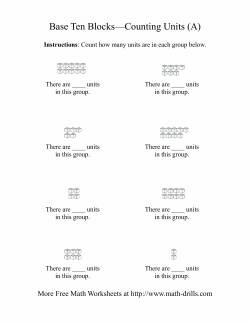
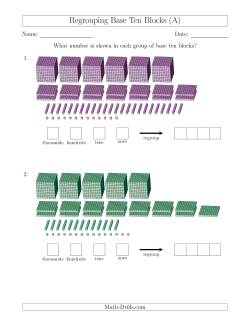
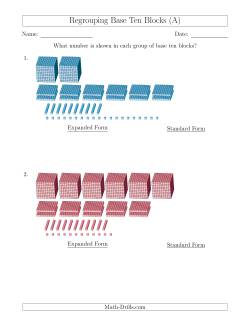
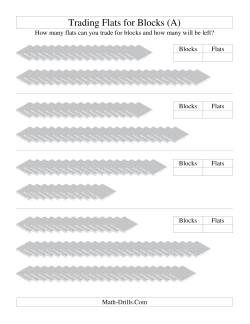
Base Ten Blocks Worksheets
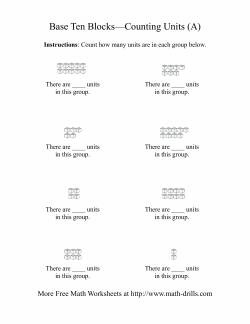
These worksheets allow students some practice in counting units, rods and flats before they encounter mixed groups. A unit cube is equal to one, so counting units is straight counting. A rod is equal to ten, so counting rods is the same as counting by tens. A flat is equal to one hundred, so counting flats is the same as counting by hundreds.
Another useful skill to practice is trading base ten blocks. Each block can be traded for 10 flats, each flat for 10 rods, and each rod for 10 cubes. Going the other way, 10 cubes can be traded for one rod, 10 rods for one flat, and 10 flats for one block. Students should become familiar with ideas such as: there are 10 ones in ten, there are 100 ones in a hundred, there are 10 tens in a hundred, and so on.
Representing numbers with base ten blocks worksheets helps students learn how to represent numbers, so they can use base ten blocks for addition, subtraction, multiplication or division.
To represent a number using base ten blocks, make piles of base ten blocks to represent each place value. If your number was 2784, you would make a pile of 2 blocks, a pile of 7 flats, a pile of 8 rods, and a pile of 4 cubes. It is useful to arrange the piles in a row in the same order that they appear in the number as that will be useful later on when children learn the paper and pencil algorithm.
These worksheets show piles of base ten blocks that are representing a number and students should be able to determine the value of the pile. Of course, going the other way is also desirable where students are given a number and they have to create the representation using base ten blocks.
One simple use of base ten blocks that translates well to a paper and pencil method of addition is to add by regrouping. To add two or more numbers, start by representing each number with base ten blocks. Put all of the cubes from both numbers in the same pile; do this with the rods, flats, and blocks as well. Next, trade any groups of 10 cubes for a rod. Trade any groups of 10 rods for a flat; then trade any groups of 10 flats for a block. To read the resulting number, count the number of base ten blocks left in each pile and read the number.
To illustrate this procedure, picture the addition question, 568 + 693. After representing both numbers with base ten blocks and combining the piles of like base ten blocks, you should have a pile of 11 cubes, a pile of 15 rods, and a pile of 11 flats. Trading 10 of the cubes for 1 rod means you now have 1 cube, 16 rods and 11 flats. Trading 10 of the rods for one flat results in 1 cube, 6 rods, and 12 flats. Trading 10 of the flats for one block gives you your final piles of 1 cube, 6 rods, 2 flats, and 1 block. The answer to the addition question, therefore, is 1,261.
These worksheets include pre-made piles of base ten blocks that students can practice regrouping.
-
Representing Numbers with Base Ten Blocks that Require Regrouping (All Blocks) Representing Numbers with Base Ten Blocks that Require Regrouping (No Thousands) Representing Numbers with Base Ten Blocks that Require Regrouping (All Blocks; Expanded Form Answers) Representing Numbers with Base Ten Blocks that Require Regrouping (No Thousands; Expanded Form Answers)
